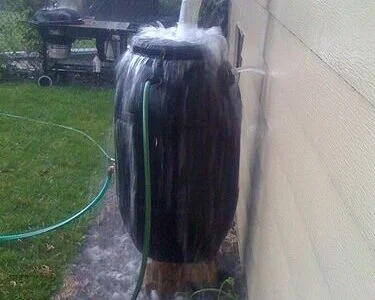
Resources
for Rainwater Systems

Clean and free
Rainwater catchment is a relatively clean and absolutely free source of water, provides an excellent back-up source for emergencies and helps slow and reduce stormwater runoff.


Cisterns and Tanks
Conveyance Systems
Calculating catchment potential

Rainwater resources continued:
Roofing Types
First flush system
Overflow design


Rainwater resources continued:
Sizing Storage Systems
Permitting and Code
Ponds and Earthworks

Integrating with Other water Systems.
Tracking Use and Water Budgets.
Implications for Stormwater Systems.




FAQs - Rainwater
What is rainwater?
Rainwater can be collected from roofs, decks and other impervious surfaces and redirected for storage for irrigation, groundwater recharge, and even indoor domestic use (with proper treatment/disinfection). Rainwater catchment is one of the simplest and oldest methods of self-supply of water for households, and can be stored in deep aquifers, ponds, and tanks of all kinds.
How much rainwater can be collected?
1” inch of rain falling on 1 square foot is equal to 0.62 gallons. To calculate the amount of total rainwater you can collect, you need to know your annual average precipitation for your area. Multiply that by 0.62 and then multiply that by the number of square feet in your roof footprint to get the answer in gallons. For example if your average annual rainfall was 20”inches and you have a 2,000 sq ft roof footprint, the calculation would be: 0.62 x 20 x 2000 = 24,800 gallons.
What are the benefits of using rainwater?
Free source of water
Relatively clean and soft water source (Low mineral content)
Self-sufficiency over water supply
Reduces stormwater runoff
Can improve drainage and flooding problems
Uses simple technologies easily available
Relatively low maintenance.
Back up emergency source to wells and municipal water system.
Easily retrofitted to existing structure or new construction
System can be easily expanded over time
Whats in rainwater?
In its essence, rainwater is pure, distilled water evaporated from the sun but rain passes through the atmosphere before falling to the ground so it can pick up contaminants in the air but most rain is perfectly safe to drink and may be even cleaner than the public water supply. Rainwater is only as clean as its collection surface and its container, so rainwater that has run off of plants, buildings or other surfaces could pick up toxic substances. Most rainwater is naturally acidic, with an average ph of around 5.0 to 5.5, caused by natural interactions between water and carbon dioxide in the air. This level of acidity of rainwater is not dangerous and even public drinking water rarely has a neutral pH, being acidic, neutral, or basic, depending on the source of the water and the dissolved minerals present.
How can rainwater be reused?
For Irrigation, non-potable Indoor use (i.e. toilet flushing) and potable indoor use (with proper treatment). Examples include:
Hand watering
Irrigation/sprinkler systems
Washing vehicles
Washing pets
Fountains and fish ponds
Swimming pools
Industrial processes
Indoor non-potable fixtures (toilets and clothes washer)
Potable uses (when properly filtered and disinfected)
Is rainwater hazardous?
While much rainwater is relatively pure, you can’t just assume it’s safe to drink. Water intended for drinking needs to be filtered, disinfected, and tested regularly. Rain can wash different types of contaminants into the water you collect (for example, bird poop on your roof could end up in your tank). Roofing materials, gutters, piping, and storage materials can introduce harmful chemicals like asbestos, lead, and copper to the water, which is why systems designed for potable re-use must adhere to strict building material standards. Boiling the water or adding chlorine or iodine will disinfect it but does not protect against chemicals. Using a “first flush diverter” to remove the first water that comes out of the system may help avoid some of the initial contaminants washed from the catchment surface. Insufficient screening can allow mosquitoes to breed in the stored water.

What roofing materials should be used?
”Standing Seam” Metal (powder coated or Galvalume) is the cleanest most efficient roofing material for rainwater catchment in new construction. Corrugated metal is also efficient but most corrugated material is galvanized, which will leach some zinc into the rainwater. Asphalt shingle is mostly inert, and generally safe for rainwater collection. The adhesives used for installation do virtually all of their off-gassing within three years of installation, so if you have a brand new asphalt shingle roof (also known as composition shingle), you may wish to avoid irrigating edibles for the first three years. Clay and concrete tiles have slightly lower collection efficiency (about 85%) because they are porous and absorb some water. Concrete tile may cause alkalinity in the water. Elastomeric roof coatings specifically for rainwater harvesting are available for rooftops that aren't otherwise safe to collect from. The National Sanitation Foundation (NSF) provides a list of approved roof coatings for potable rainwater catchment systems.
.
What is the Cost/ Benefit Analysis of rainwater Systems?
It depends a lot on the local cost/availability of freshwater and also the valuation of abstract benefits such as emergency preparedness or stormwater runoff reduction. Compared to Graywater which is produced year round in many Mediterranean climates rain only falls during cool winter months when irrigation water isn’t needed anyway, so storage volumes need to be relatively large to replace significant percentages of the freshwater used for irrigation. However, rain is a much inherently cleaner water source than graywater, so it can be used for more diverse uses and also stored longterm. Cost/benefit analysis can be drastically shifted in certain situations such as
failing or unavailable freshwater system
Emergency water shortage
Large volumes of low cost storage (i.e. ponds)
What roofing materials should NOT be used?
Cedar Shake: Wood shingles are treated with fire retardants but may still be suitable for irrigation.
Copper: Copper roofs can leach into your rainwater, which isn't ideal as copper is a herbicide.
Lead: Lead flashing still available in some parts of the USA.
Biocides: Some rooftops are treated with biocides (i.e. Zinc- or copper-treated shingles)
Is rainwater collection legal?
Rainwater collection is allowed in most but not all places. Some states consider rainwater the property of the state and prohibit its collection. so you should consult with your local government (i.e. environmental health department) before planning your system. Many jurisdictions allow tanks under 5,000 gallons installed on grade to be installed without a permit. Systems utilizing a pump will likely be required to install an approved BFPD (backflow prevention device)on their potable water supply to prevent an inadvertent cross connection back into the public supply.
When NOT to collect rainwater?
Some states consider rainwater the property of the state and prohibit its collection. so you should consult with your local government (i.e. environmental health department) before planning your system.
Should my rainwater system have a pump or not?
Many distribution systems (such as hand watering) will work from gravity flow alone. Elevation and water pressure have a relationship where each foot of height you have contributes 0.4 PSI (pounds per square inch(the unit used to measure pressure)) of pressure to your system, such that an elevated water tower tank at 100 ft tall provides 40 PSI of pressure from gravity alone. Using gravity will work as long as the water level in your tank is higher than where you’re distributing the water, but a pump will allow you to pressurize the water which uses electricity but facilitates distribution and control to some extent. Many filters, solenoid valves, and drip emitters require a minimum water pressure to work correctly. Having a pump also increases a systems multi-functionality for backup fire protection.




























